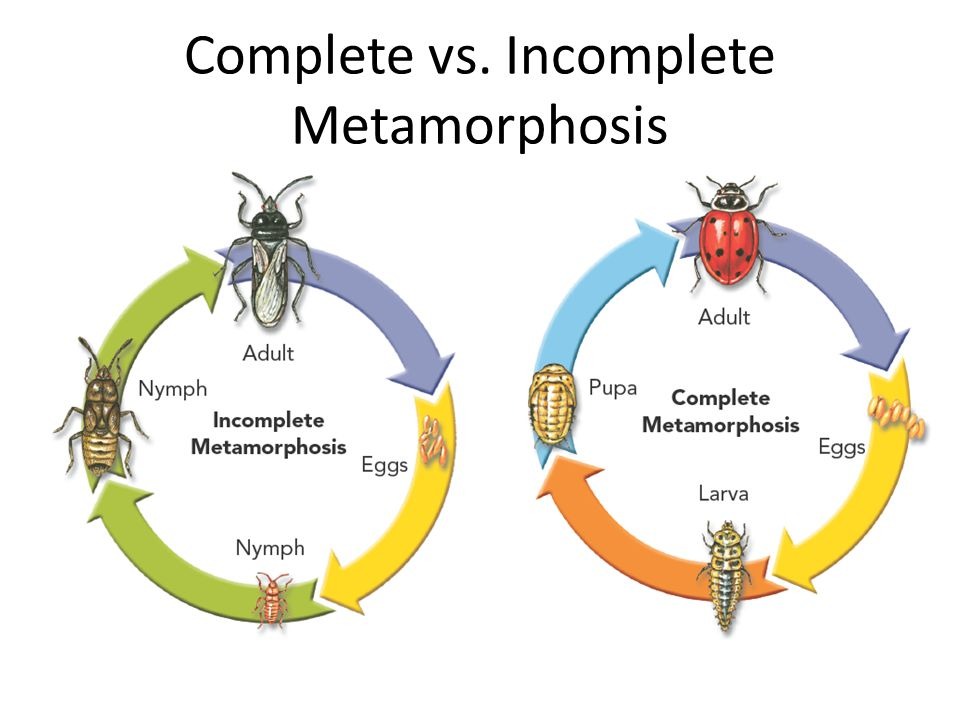Metamorphosis is the change in body and habitats during the development cycle of animals. It majorly occurs in insects.
Complete and incomplete metamorphoses are the two types of growth that occur in insects during growth and development.
Both types of metamorphosis start from the egg stage to the adult stage. The stages between the cycles are the ones that differ hence the two types of metamorphosis.
So, what is the main difference between complete and incomplete metamorphosis? The complete metamorphosis contains very active and eating larva and inactive pupa while incomplete metamorphosis consists of a nymph that resembles a miniature adult.
More about the differences between complete and incomplete metamorphosis are contained in this article and you will also get to know about the similarities between the two.

Comparison Table (Complete Vs Incomplete Metamorphosis)
| Basic Terms | Complete Metamorphosis | Incomplete Metamorphosis |
| Definition | Refers to a type of insect development whose egg, larva, pupa, and adult are completely different from each other. | Refers to a type of insect development where gradual changes occur in the insect during the development from egg to adult. |
| Number of stages | Contains four stages; egg, larva, pupa, and adult. | Contains three stages; egg, nymph, and adult. |
| Stage two | It consists of a larva which are very active, ravenous eating creatures. | It consists of a nymph which resembles a miniature adult. |
| Exoskeleton | It is completely molted during complete metamorphosis. | Certain parts of the exoskeleton remain throughout the insect’s lifetime. |
| Reproductive ability | The final stage becomes reproductively successful. | Some stages are reproductively successful. |
| Examples | It occurs in wasps, ants, and fleas. | It occurs in termites, praying mantes, and cockroaches. |
What Is Complete Metamorphosis?
Complete metamorphosis is a type of insect development that contains four stages that is egg, larva, pupa, and adult and the stages differ morphologically.
The stage starts with the female insects laying eggs, and when they hatch to the larval stage which is worm-like and differs behaviorally, habitat from the adult.
They grow very fast as they have a high appetite for food. During the stage, the larva molts several times. The pupa stage comes in with the formation of cocoons around the larva.
While in cocoons, they are inactive and their bodies develop more organs. This may happen between 4 days extending to several months where they will come out as adults.
What Is Incomplete Metamorphosis?
Incomplete metamorphosis is a type of insect development where gradual changes occur between the egg stage and the adult.
It contains three stages which are egg, nymph, and adult. It starts with the female insects laying eggs. Their eggs are mostly covered with egg cases to enable them to hold together.
The eggs hatch into nymphs which resembles the adults although they do not have wings. They are smaller in body size than the adults but they feed on the same food as the adults.
The nymph sheds its exoskeleton several times before it becomes an adult. After it has turned to adult, it no longer shed off its exoskeleton.
Main Differences between Complete and Incomplete Metamorphosis
- Complete metamorphosis refers to a type of insect development where the developmental stages are different from each other morphologically while incomplete metamorphosis is a type of development in insects where changes in their body occur gradually during their lifetime.
- Complete metamorphosis has four developmental stages while incomplete metamorphosis contains three stages.
- The complete metamorphosis contains larva which are very active, ravenous eating larva while incomplete metamorphosis contains nymph which resembles adults.
- In complete metamorphosis, the exoskeleton is shed while in the incomplete metamorphosis the exoskeleton may remain throughout the lifetime.
- Reproductive ability is found in adults incomplete metamorphosis while in incomplete metamorphosis reproductive ability is successful in some former stages.
Similarities between Complete and Incomplete Metamorphosis
- They are both types of growth in insects.
- In both the body form of insects changes.
- They both start with the egg stage and extend to the adult stage.
- A series of molts occur in both as they grow into adults.
Conclusion
Complete and incomplete metamorphoses are stages of growth and development in insects. The two occur in stages where they start with the egg stage and end with the adult stage.
Complete metamorphosis occurs in four stages; egg, larva, pupa, and adult. Incomplete metamorphosis occurs in three stages; egg, nymph, and adult.
The main difference between the two is, incomplete metamorphosis, the pupa stage is not present hence making the two differ from each other.